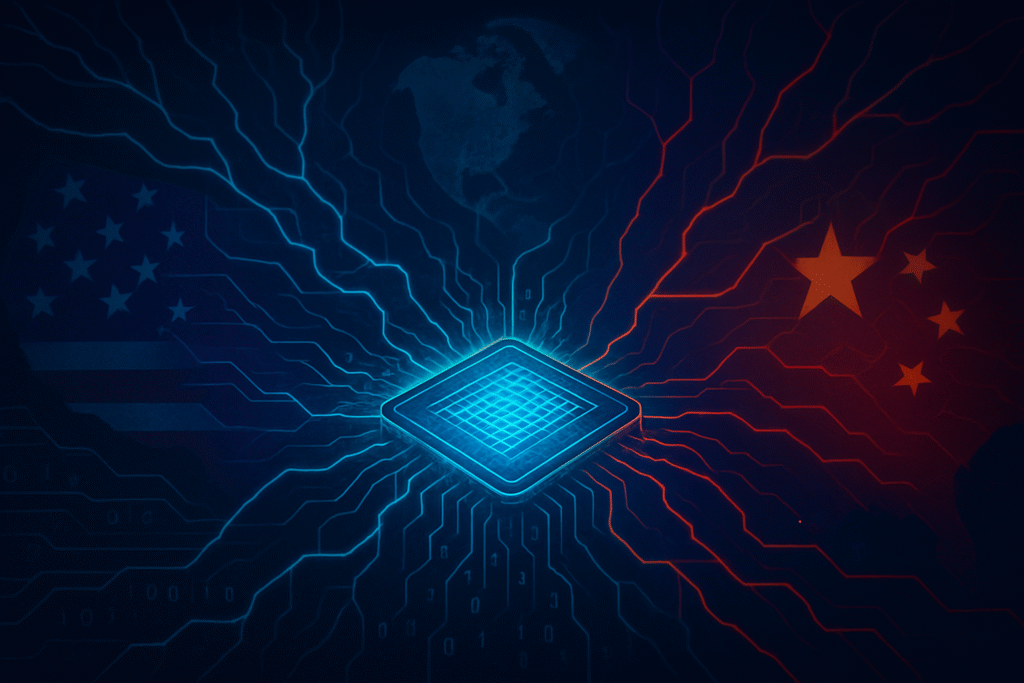The Great Chip Divide: US-China Tech War Reshapes Global Semiconductor Landscape

The US-China tech war has reached an unprecedented intensity by October 2025, profoundly reshaping the global semiconductor industry. What began as a strategic rivalry has evolved into a full-blown struggle for technological supremacy, creating a bifurcated technological ecosystem and an 'AI Cold War.' This geopolitical conflict is not merely about trade balances but about national security, economic dominance, and the future of artificial intelligence, with the semiconductor sector at its very core. The immediate significance is evident in the ongoing disruption of global supply chains, a massive redirection of investment towards domestic capabilities, and unprecedented challenges for multinational chipmakers navigating a fractured market.
Technical Frontlines: Export Controls, Indigenous Innovation, and Supply Chain Weaponization
The technical ramifications of this conflict are far-reaching, fundamentally altering how semiconductors are designed, manufactured, and distributed. The United States, through increasingly stringent export controls, has effectively restricted China's access to advanced computing and semiconductor manufacturing equipment. Since October 2022, and with further expansions in October 2023 and December 2024, these controls utilize the Entity List and the Foreign Direct Product Rule (FDPR) to prevent Chinese entities from acquiring cutting-edge chips and the machinery to produce them. This has forced Chinese companies to innovate rapidly with older technologies or seek alternative, less advanced solutions, often leading to performance compromises in their AI and high-performance computing initiatives.
Conversely, China is accelerating its 'Made in China 2025' initiative, pouring hundreds of billions into state-backed funds to achieve self-sufficiency across the entire semiconductor supply chain. This includes everything from raw materials and equipment to chip design and fabrication. While China has announced breakthroughs, such as its 'Xizhi' electron beam lithography machine, the advanced capabilities of these indigenous technologies are still under international scrutiny. The technical challenge for China lies in replicating the intricate, multi-layered global expertise and intellectual property that underlies advanced semiconductor manufacturing, a process that has taken decades to build in the West.
The technical decoupling also manifests in retaliatory measures. China, leveraging its dominance in critical mineral supply chains, has expanded export controls on rare earth production technologies, certain rare earth elements, and lithium battery production equipment. This move aims to weaponize its control over essential inputs for high-tech manufacturing, creating a new layer of technical complexity and uncertainty for global electronics producers. The expanded 'unreliable entity list,' which now includes a Canadian semiconductor consultancy, further indicates China's intent to control access to technical expertise and analysis.
Corporate Crossroads: Navigating a Fractured Global Market
The tech war has created a complex and often precarious landscape for major semiconductor companies and tech giants. US chipmakers like Nvidia (NASDAQ: NVDA) and Advanced Micro Devices (AMD) (NASDAQ: AMD), once heavily reliant on the lucrative Chinese market, now face immense pressure from US legislation. Recent proposals, including a 100% tariff on imported semiconductors and Senate legislation requiring priority access for American customers for advanced AI chips, underscore the shifting priorities. While these companies have developed China-specific chips to comply with earlier export controls, China's intensifying crackdown on advanced AI chip imports and instructions to domestic tech giants to halt orders for Nvidia products present significant revenue challenges and force strategic re-evaluations.
On the other side, Chinese tech giants like Huawei and Tencent are compelled to accelerate their indigenous chip development and diversify their supply chains away from US technology. This push for self-reliance, while costly and challenging, could foster a new generation of Chinese semiconductor champions in the long run, albeit potentially at a slower pace and with less advanced technology initially. The competitive landscape is fragmenting, with companies increasingly forced to choose sides or operate distinct supply chains for different markets.
Taiwan Semiconductor Manufacturing Company (TSMC) (NYSE: TSM), the world's largest contract chipmaker and a critical linchpin in the global supply chain, finds itself at the epicenter of these tensions. While some Taiwanese firms benefit from diversification strategies away from China, TSMC's significant manufacturing presence in Taiwan makes it a focal point of geopolitical risk. The US CHIPS and Science Act, which prohibits recipients of funding from expanding advanced semiconductor manufacturing in China for 10 years, directly impacts TSMC's global expansion and investment decisions, pushing it towards greater US-based production.
Broader Implications: Decoupling, Geopolitics, and the Future of AI
This ongoing tech war fundamentally alters the broader AI landscape and global technological trends. It accelerates a trend towards technological decoupling, where two distinct and potentially incompatible technological ecosystems emerge, one centered around the US and its allies, and another around China. This fragmentation threatens to reverse decades of globalization, leading to inefficiencies, increased costs, and potentially slower overall technological progress due to reduced collaboration and economies of scale. The drive for national self-sufficiency, while boosting domestic industries, also creates redundancies and stifles the free flow of innovation that has historically fueled rapid advancements.
The impacts extend beyond economics, touching upon national security and international relations. Control over advanced semiconductors is seen as critical for military superiority, AI development, and cybersecurity. This perception fuels the aggressive policies from both sides, transforming the semiconductor industry into a battleground for geopolitical influence. Concerns about data sovereignty, intellectual property theft, and the weaponization of supply chains are paramount, leading to a climate of mistrust and protectionism.
Comparisons to historical trade wars or even the Cold War's arms race are increasingly relevant. However, unlike previous eras, the current conflict is deeply intertwined with the foundational technologies of the digital age – semiconductors and AI. The stakes are arguably higher, as control over these technologies determines future economic power, scientific leadership, and even the nature of global governance. The emphasis on 'friend-shoring' and diversification away from perceived adversaries marks a significant departure from the interconnected global economy of the past few decades.
The Road Ahead: Intensifying Rivalry and Strategic Adaptation
In the near term, experts predict an intensification of existing policies and the emergence of new ones. The US is likely to continue refining and expanding its export controls, potentially targeting new categories of chips or manufacturing equipment. The proposed 100% tariff on imported semiconductors, if enacted, would dramatically reshape global trade flows. Simultaneously, China will undoubtedly double down on its indigenous innovation efforts, with continued massive state investments and a focus on overcoming technological bottlenecks, particularly in advanced lithography and materials science.
Longer term, the semiconductor industry could see a more permanent bifurcation. Companies may be forced to maintain separate research, development, and manufacturing facilities for different geopolitical blocs, leading to higher operational costs and slower global product rollouts. The race for quantum computing and next-generation AI chips will likely become another front in this tech war, with both nations vying for leadership. Challenges include maintaining global standards, preventing technological fragmentation from stifling innovation, and ensuring resilient supply chains that can withstand future geopolitical shocks.
Experts predict that while China will eventually achieve greater self-sufficiency in some areas of semiconductor production, it will likely lag behind the cutting edge for several years, particularly in the most advanced nodes. The US and its allies, meanwhile, will focus on strengthening their domestic ecosystems and tightening technological alliances to maintain their lead. The coming years will be defined by a delicate balance between national security imperatives and the economic realities of a deeply interconnected global industry.
Concluding Thoughts: A New Era for Semiconductors
The US-China tech war's impact on the global semiconductor industry represents a pivotal moment in technological history. Key takeaways include the rapid acceleration of technological decoupling, the weaponization of supply chains by both nations, and the immense pressure on multinational corporations to adapt to a fractured global market. This conflict underscores the strategic importance of semiconductors, not just as components of electronic devices, but as the foundational elements of future economic power and national security.
The significance of this development in AI history cannot be overstated. With AI advancements heavily reliant on cutting-edge chips, the ability of nations to access or produce these semiconductors directly impacts their AI capabilities. The current trajectory suggests a future where AI development might proceed along divergent paths, reflecting the distinct technological ecosystems being forged.
In the coming weeks and months, all eyes will be on new legislative actions from both Washington and Beijing, the financial performance of key semiconductor companies, and any breakthroughs (or setbacks) in indigenous chip development efforts. The ultimate long-term impact will be a more resilient but potentially less efficient and more costly global semiconductor supply chain, characterized by regionalized production and intensified competition for technological leadership.
This content is intended for informational purposes only and represents analysis of current AI developments.
TokenRing AI delivers enterprise-grade solutions for multi-agent AI workflow orchestration, AI-powered development tools, and seamless remote collaboration platforms.
For more information, visit https://www.tokenring.ai/.
More News
View More




Recent Quotes
View More
Quotes delayed at least 20 minutes.
By accessing this page, you agree to the Privacy Policy and Terms Of Service.